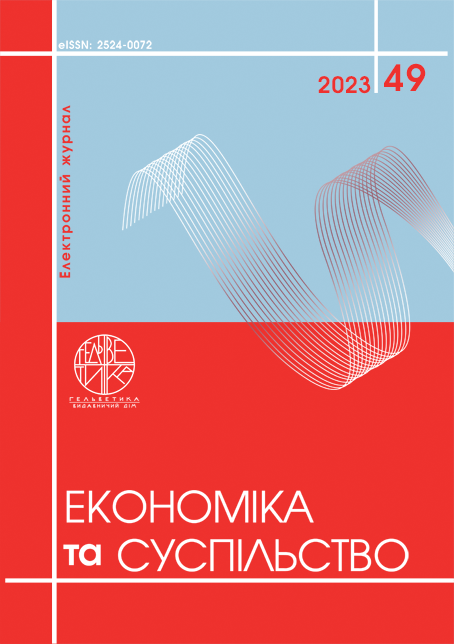BELIEVE OR NOT BELIEVE: HOW INFORMATION ON SOCIAL NETWORKS INFLUENCES USER ATTITUDES
Abstract
This study determines the value of information that is distributed in social networks for assessing personal attitudes towards the object of this information. In particular, we analyzed the individual attitude of people to negative information and determined the value of the source of information in relation to the degree of trust in it. For this purpose, we considered the behavior of persons who received negative information. We then investigated and measured the economic outcomes of this behavior. We used social networks and instant messaging systems to conduct research. After all, the asymmetry of information is strongly expressed in social networks and messengers due to the social differences of users of these Internet resources. Our main focus in this study is to evaluate the effect of negative information and study possible ways to correct the damage caused by this information. We conducted two studies to assess individual reactions to information (reliable – unreliable; positive – negative) of social network users. In the first study, we presented 458 participants with positive and negative information about environmental pollution using reliable and less reliable information sources. The conclusions of this experiment indicate that the damage caused by negative information can be corrected if such information comes from an unreliable source. In the second study, we determined the degree of sensitivity to negative information as a result of evaluating the reactions of social network users. We came to the conclusion that the value of the sphere of life activity (dietary nutrition, interior design, restaurants and cafes, car spare parts) is positively correlated with the amount of negative information. The obtained results indicate a significant positive correlation between the initial assessment (attitude towards the sphere of life activity) and the damage caused by negative information. In other words, the higher the baseline assessment of the sphere of life activity, the more damage was done to her and the more damage remained to her even after the information was denied. One explanation for this result could be greater sensitivity to negative information because participants value these areas more. Negative information that spreads in social networks determines the individual attitude towards the object of these negative comments. The amount of negative information also has a significant impact on readers' attitudes, with negative comments causing more damage. Research results confirm that people are able to recognize reliable information from an unreliable source.
References
Попик В. І., Горовий В. М., Онищенко О. С. та ін. Проблеми суспільної безпеки в процесі розвитку соціальних мереж. URL: http://nbuviap.gov.ua/images/nauk-mon/problemu_susp_bezpeku.pdf
Градосельская Г. В. Мережеві вимірювання в соціології. М.: Новий дім, 2004. URL: http://cozap.com.ua/text/17941/index-1.html
Evangelista, A. (2004). Echocardiography in infective endocarditis. Heart, 90(6), 614–617. DOI: https://doi.org/10.1136/hrt.2003.029868
Richey, M. H., Koenigs, R. J., Richey, H. W., & Fortin, R. (1975). Negative Salience in Impressions of Character: Effects of Unequal Proportions of Positive and Negative Information. The Journal of Social Psychology, 97(2), 233–241. DOI: https://doi.org/10.1080/00224545.1975.9923343
Hardt, J., & Rutter, M. (2004). Validity of adult retrospective reports of adverse childhood experiences: a review of the evidence. Journal of Child Psychology and Psychiatry, 45(2), 260–273. DOI: https://doi.org/10.1111/j.1469-7610.2004.00218.x
Spence, M. (1973). Job Market Signaling. The Quarterly Journal of Economics, 87(3), 355–374. URL: https://www.jstor.org/stable/1882010
Popyk V. I., Horovyy V. M., Onyshchenko O. S. ta in. Problemy suspilʹnoyi bezpeky v protsesi rozvytku sotsialʹnykh merezh. Available at: http://nbuviap.gov.ua/images/nauk-mon/problemu_susp_bezpeku.pdf
Hradoselʹskaya H. V. Merezhevi vymiryuvannya v sotsiolohiyi. M.: Novyy dim, 2004. Available at: http://cozap.com.ua/text/17941/index-1.html
Evangelista, A. (2004). Echocardiography in infective endocarditis. Heart, 90(6), 614–617. DOI: https://doi.org/10.1136/hrt.2003.029868
Richey, M. H., Koenigs, R. J., Richey, H. W., & Fortin, R. (1975). Negative Salience in Impressions of Character: Effects of Unequal Proportions of Positive and Negative Information. The Journal of Social Psychology, 97(2), 233–241. DOI: https://doi.org/10.1080/00224545.1975.9923343
Hardt, J., & Rutter, M. (2004). Validity of adult retrospective reports of adverse childhood experiences: a review of the evidence. Journal of Child Psychology and Psychiatry, 45(2), 260–273. DOI: https://doi.org/10.1111/j.1469-7610.2004.00218.x
Spence, M. (1973). Job Market Signaling. The Quarterly Journal of Economics, 87(3), 355–374. Available at: https://www.jstor.org/stable/1882010

This work is licensed under a Creative Commons Attribution 4.0 International License.


